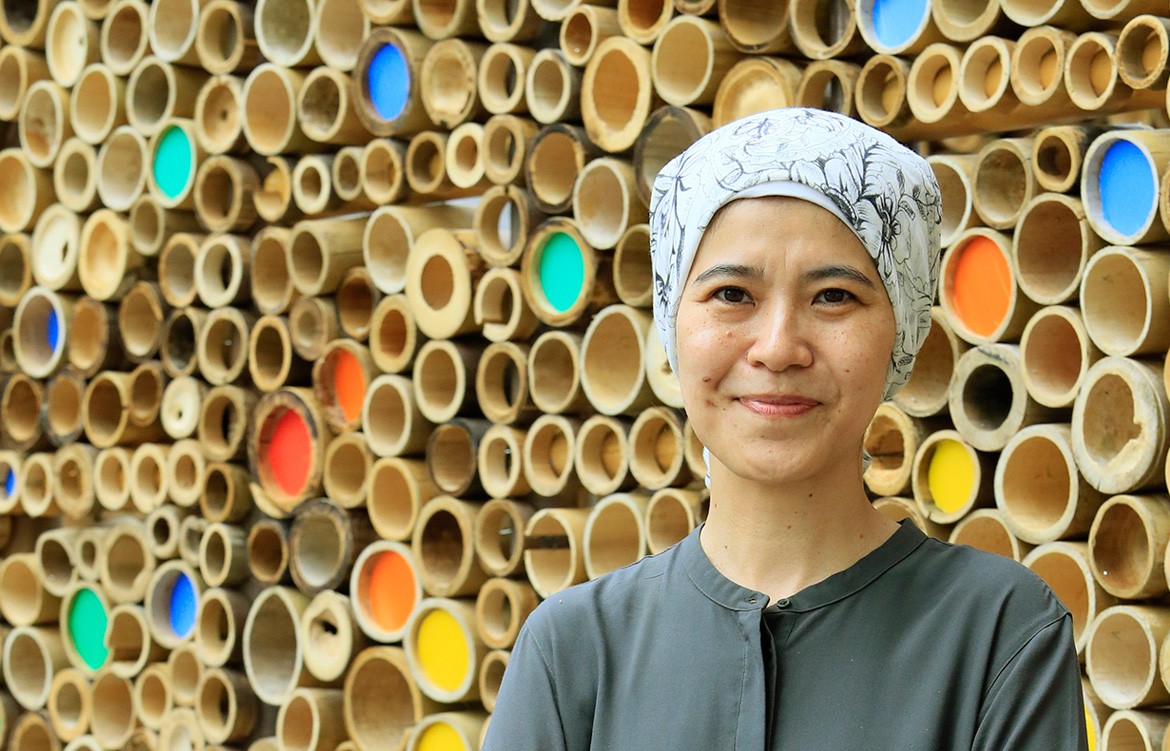In a quiet square in one of the oldest parts of the city of Kuala Lumpur sits a small bamboo pavilion. The pavilion, designed by Eleena Jamil Architects for UNHabitat, is an unassuming yet affecting place. Composed of bamboo ring walls with coloured, writeable panels, the little structure greets passers-by with an invitation to contribute their pledges and ideas for a better, more sustainable city.
This humble project is symptomatic of Eleena Jamil’s broader body of work; an œuvre that is riddled with well-considered architectural interventions whose small scale often belies something more deeply felt. Or, in her own words:
“I think small things can make a huge impact to a place if well-designed. I like the idea of a small intervention charging the spaces around it with connective possibilities, allowing others to see the potential and do something. This is what we try to do with our projects.”
Having grown up in a family that was involved in the construction business, Eleena says architecture was always something that “made sense” to her. At age 18, she left home to pursue studies in the United Kingdom, taking up a construction course at Brighton College of Technology before moving onto an architectural degree at Cardiff University’s Welsh School of Architecture.
In 2005, this academic groundwork culminated in the creation of her own eponymous practice, Eleena Jamil Architects (EJA). Although EJA has experienced no shortage of accolades during the near 17 years in practice, Eleena made a conscious decision to avoid the pitfalls that often accompany such growth. EJA might have matured from an at-home operation to a fully-fledged business occupying commercial space, but it still behaves like a small firm, driven by passion projects and underscored with ethics.
“Being small and selective allows us to focus on projects that really appeal to us, and this leads to a portfolio comprising what I feel to be interesting projects,” says Eleena. “It is such a huge privilege to have the freedom to work on projects that I am passionate about. For every project – large or small – my team and I spend a lot of time developing ideas until we are truly happy with the result. We hope that each work that we produce is not only socially responsible and sustainable, but also a delight to use and experience.”
It is not only the size of Eleena’s “architectural interventions” that distinguishes them; it is also in their considered and often idiosyncratic forms and materiality. At a time when Kuala Lumpur – and Malaysia more broadly – is looking to soaring glass towers as a symbol of its development, Eleena sees the virtue in a kind of architecture more deeply rooted in place and demonstrative of local materials.
“I’m always looking for patterns that surround me, whether tangible or intangible,” says Eleena. “Often, my work is inspired by patterns seen in cultural artefacts, or patterns of movement and habit (i.e. how a space is used). Patterns that arise from responses to local climate are particularly interesting to me. I believe that understanding these patterns is important in connecting a building to place.
“For instance, we use bamboo in a lot of our projects. It’s a wonderful building material – cheap, strong, sustainable, and very light. We also love local timber, but it is used in the way that all precious things should be used: sparingly and with consideration.”
Until now, this locally driven philosophy has kept Eleena’s practice largely in place. But this doesn’t mean her style isn’t transferable. In the future, Eleena says, she would like to take her work more often outside of Malaysia. She sees international projects as “an opportunity to create interesting spaces and forms that respond to different local cultures and climates”.
This desire to impact through architecture manifests itself in many different ways outside of architecture itself. In 2018, Eleena plans on carving out some time to conduct research on social housing, and to take up architectural photography. Over the coming months, she’ll also be lending her expertise to Indesign Media as a judge for the second ever INDE.Awards, to be held in Singapore this June with an Australian live-streaming event.
“The idea of an awards program focused on the Asia-Pacific region – where the economies, cultures and concerns are so diverse – is exciting,” she says. “It’s a dynamic part of the world that is changing rapidly in architectural and design terms and I very much look forward to seeing the best this region has to offer.”
Eleena Jamil Architects
ej-architect.com
Portrait by DD Hoe
We think you might also like In Conversation With… Deyan Sujic

